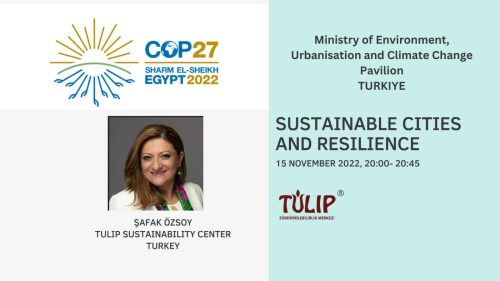The COP27 climate conference is over now. COP26 was much stronger than COP27 because it set clear mitigation targets and because more than 40 countries – including major coal-consuming nations like Poland, Vietnam and Chile – committed to shift away from coal. But some of the world’s biggest coal-dependent countries, including China and the US, still did not sign up.
COP27 has ended, but the impact of climate change is increasing on us all. It is urgent for economies to become carbon neutral, but many leaders are not showing up to take the actions needed for a better tomorrow, specifically keeping global warning below 1.5 C. That ambitious goal – and even the weaker one of keeping temperature rise below 2 C – are getting away from us. This is the climate century, when resilience has to replace economic development as the focus of our collective lives. Here’s how Rotarians can make a real contribution to this transformation.
By 2030, almost 50% of the world’s population will live in cities highly vulnerable to climate and disaster risks. That proportion will rise to almost 60% of us by 2050. Cities already account for 70% of greenhouse gas emissions and 80% of the world’s GDP. Because Rotarians are local leaders, we are ideally placed to encourage our cities to adopt resilience plans. I gave a talk at COP27 on excellent tools available for free from UNDDR and OECD, and will provide links and more information about the resilience process below.
COP27 brought together more than 45,000 participants with the hope there would be no greenwashing but I am afraid the opposite occurred. The most important advance from this year’s negotiations is the agreement to create the loss and damage fund. Loss and damage refers to the irreversible economic and non-economic costs of extreme weather events such as hurricanes, heat waves, drought and wildfires, and slow-onset climate disasters such as sea-level rise and melting glaciers. It’s about holding the biggest fossil fuel polluters liable for the pain and suffering already caused by the climate crisis. This compensation is separate from – and in addition to – securing climate finance for mitigation and to help developing nations prepare for what’s coming.
Economic costs include the lives, livelihoods, homes, food systems and territory irreversibly lost. The harder-to-quantify non-economic costs refer to the loss of culture, identity, sovereignty, human dignity, biodiversity, and psychological well-being. As a result, funding for loss and damage has become a central tenet in demands for climate justice or, in other words, climate action that addresses the inequities behind the climate crisis.
Rotarians can help our cities build early warning systems and observation to guide resilience processes. This can identify where investments – including from the loss and damage fund – can be most effective. The UN Office for Disaster Risk Reduction (UNDRR) offers valuable analytic tools for cities to use to assess both strengths and vulnerabilities in the quest to maintain continuity through all shocks and stresses, while making progress towards sustainability. Each city has a different dynamic.
The UNDRR tools, including a Disaster Resilience Scorecard, allow you to analyze your city as a system of systems, including food storage and delivery, water and wastewater, ecosystem services, healthcare, public safety, transportation, protective infrastructure, and communications and IT. The Organisation for Economic Co-operation and Development (OECD) offers a model which identifies economic, social, governance, and environmental conditions that create urban resilience. Understanding the assets and weaknesses becomes the baseline for mobilizing all stakeholders and working intentionally to build up the knowledge, mutual accountability, and implementation plan the city needs to become resilient and operate sustainably. We are using this approach in Turkiye with five major cities that include almost 40% of our population. Turkish cities are very open to resilience thinking.
For Rotarians, mitigation of and adaptation to climate change fits our mission of service to our societies. We must bring together all stakeholders of our societies to achieve carbon neutrality. In addition to our professional expertise and networks, we will keep the focus on equity, thanks to the Four-Way Test – particularly the criteria of being fair to all and promoting outcomes beneficial to all concerned.
COP 27’s outcomes are not enough to support the ambitious target of getting rid of fossil fuels, but as I always say, this is the climate century. Next year COP28 will bring hopes again. Stronger targets will be on the table if all stakeholders come together and support climate-related processes. We have to transition away from fossil fuels: that is simply a fact. But the time for adaptation is long past: now we have to focus on making our communities resilient.
Safak Özsoy is the founder and director of the Tulip Sustainability Center, a consulting firm in Istanbul which provides sustainability management consulting to municipalities and businesses. She led the UNDRR 2030 sustainability planning work for Istanbul and four other major Turkish cities which was concluded in September, 2022, and spoke about urban resilience during COP27 at the invitation of the Turkish Ministry of Environment, Urbanisation, and Climate Change She is ESRAG Chair for Rotary Zone 21.

